Venus' mysterious night side revealed
14 September 2017
Scientists have used ESA's Venus Express to characterise the wind and upper cloud patterns on the night side of Venus for the first time–with surprising results.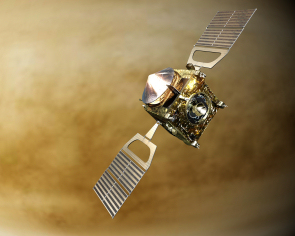 |
| Venus Express in orbit. Credit: ESA |
The study shows that the atmosphere on Venus' night side behaves very differently to that on the side of the planet facing the Sun (the 'dayside'), exhibiting unexpected and previously-unseen cloud types, morphologies, and dynamics - some of which appear to be connected to features on the planet's surface.
"This is the first time we've been able to characterise how the atmosphere circulates on the night side of Venus on a global scale," says Javier Peralta of the Japan Aerospace Exploration Agency (JAXA), Japan, and lead author of the new study published in the journal Nature Astronomy. "While the atmospheric circulation on the planet's dayside has been extensively explored, there was still much to discover about the night side. We found that the cloud patterns there are different to those on the dayside, and influenced by Venus' topography."
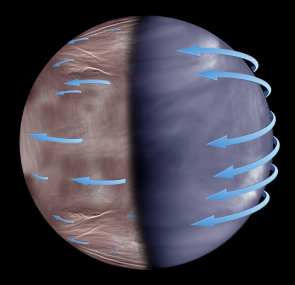 |
| Atmospheric super-rotation at the upper clouds of Venus. Credit: ESA, JAXA, J. Peralta and R. Hueso |
Venus' atmosphere is dominated by strong winds that whirl around the planet far faster than Venus itself rotates. This phenomenon, known as 'super-rotation', sees Venusian winds rotating up to 60 times faster than the planet below, pushing and dragging along clouds within the atmosphere as they go. These clouds travel fastest at the upper cloud level, some 65 to 72 km above the surface.
"We've spent decades studying these super-rotating winds by tracking how the upper clouds move on Venus' dayside–these are clearly visible in images acquired in ultraviolet light," explains Peralta. "However, our models of Venus remain unable to reproduce this super-rotation, which clearly indicates that we might be missing some pieces of this puzzle.
"We focused on the night side because it had been poorly explored; we can see the upper clouds on the planet's night side via their thermal emission, but it's been difficult to observe them properly because the contrast in our infrared images was too low to pick up enough detail."
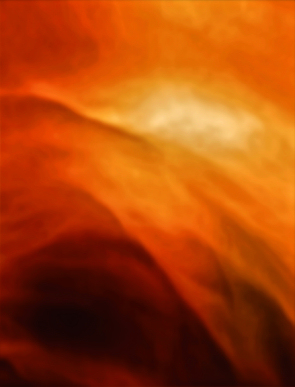 |
| Mysterious fast filaments in clouds on Venus. Credit: ESA, S. Naito, R. Hueso and J. Peralta |
The team used the Visible and Infrared Thermal Imaging Spectrometer (VIRTIS) on ESA's Venus Express spacecraft to observe the clouds in the infrared. "VIRTIS enabled us to see these clouds properly for the first time, allowing us to explore what previous teams could not–and we discovered unexpected and surprising results," adds Peralta.
Rather than capturing single images, VIRTIS gathered a 'cube' of hundreds of images of Venus acquired simultaneously at different wavelengths. This allowed the team to combine numerous images to improve the visibility of the clouds, and see them at unprecedented quality. The VIRTIS images thus reveal phenomena on Venus' night side that have never before been seen on the dayside.
The best models for how Venus' atmosphere behaves and circulates, known as Global Circulation Models (GCMs), predict super-rotation to occur in much the same way on Venus' night side as on its dayside. However, this research by Peralta and his colleagues contradicts these models.
Instead, the super-rotation seems to be more irregular and chaotic on the night side.
Night side upper clouds form different shapes and morphologies than those found elsewhere–large, wavy, patchy, irregular, and filament-like patterns, many of which are unseen in dayside images–and are dominated by unmoving phenomena known as stationary waves.
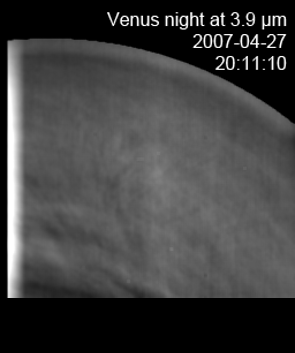 |
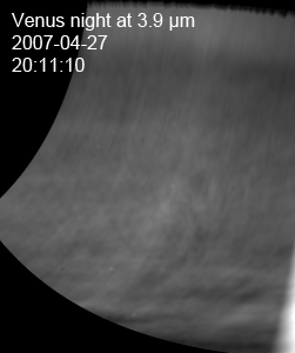 |
| Stationary waves in clouds on Venus. Credit: ESA/VIRTIS/J. Peralta and R. Hueso | |
"Stationary waves are probably what we'd call gravity waves–in other words, rising waves generated lower in Venus' atmosphere that appear not to move with the planet's rotation," says co-author Agustin Sánchez-Lavega of University del País Vasco in Bilbao, Spain. "These waves are concentrated over steep, mountainous areas of Venus; this suggests that the planet's topography is affecting what happens way up above in the clouds."
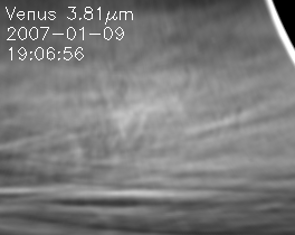 |
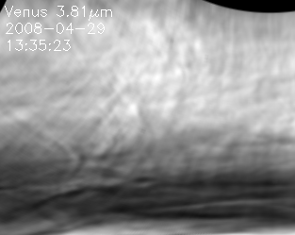 |
| Stationary waves in clouds on Venus. Credit: ESA/VIRTIS/J. Peralta and R. Hueso | |
The 3D properties of these stationary waves were also obtained by combining VIRTIS data with radio-science data from the Venus Radio Science experiment, or VeRa, also on Venus Express.
A link between atmospheric motion and topography has been spied on Venus before, although on the dayside; in a study from last year, researchers found weather patterns and rising waves on the dayside of Venus to be directly connected to topographic features on the surface.
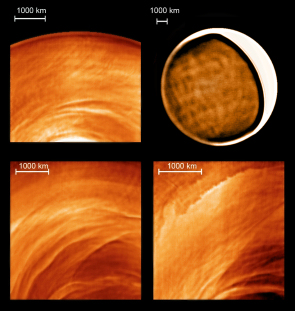 |
| New types of cloud morphology on Venus. Credit: ESA, NASA, J. Peralta and R. Hueso |
"It was an exciting moment when we realised that some of the cloud features in the VIRTIS images didn't move along with the atmosphere," says Peralta. "We had a long debate about whether the results were real–until we realised that another team, led by co-author Dr. Kouyama, had also independently discovered stationary clouds on the night side using NASA's Infrared Telescope Facility (IRTF) in Hawaii! Our findings were confirmed when JAXA's Akatsuki spacecraft was inserted into orbit around Venus and immediately spotted the biggest stationary wave ever observed in the Solar System on Venus' dayside."
This finding raises challenges for existing models of stationary waves. Such waves were expected to be formed by surface winds interacting with obstacles such as surface elevations–a mountain, for example. However, previous Russian missions involving landers have measured surface winds on Venus that may be too weak for this to be true.
Additionally, the planet's southern hemisphere (where VIRTIS observed) is generally quite low in elevation, and–more mysteriously–stationary waves appear to be missing in Venus' intermediate and lower cloud levels (up to roughly 50 km above the surface).
"We expected to find these waves in the lower levels because we see them in the upper levels, and we thought that they rose up through the cloud from the surface," says co-author Ricardo Hueso of University of the Basque Country in Bilbao, Spain. "It's an unexpected result for sure, and we'll all need to revisit our models of Venus to explore its meaning."
The effect of topography on atmospheric circulation remains unclear among climate modellers; many models show that the inclusion or omission of surface topography makes a difference to the resulting behaviour seen in Venus' atmosphere, but do not show persistent weather patterns linked to topography.
"This study challenges our current understanding of climate modelling and, specifically, the super-rotation, which is a key phenomenon seen at Venus," says Håkan Svedhem, ESA Project Scientist for Venus Express. "Additionally, it demonstrates the power of combining data from multiple different sources–in this case, remote sensing and radio-science data from Venus Express' VIRTIS and VeRa, complemented by ground-based observations from IRTF's SpeX. This is a significant result for VIRTIS and for Venus Express, and is very important for our knowledge of Venus as a whole."
Notes for editors
This research is reported in 'Stationary waves and slowly moving features in the night upper clouds of Venus', by J. Peralta et al., published on 24 July 2017 in Nature Astronomy. doi: 10.1038/s41550-017-0187.
Akatsuki's discovery of a large stationary wave on the dayside of Venus is described in a paper ('Large stationary gravity wave in the atmosphere of Venus') by T. Fukuhara et al., published in the journal Nature Geoscience in January 2017. doi:10.1038/ngeo2873.
Co-author T. Kouyama of the National Institute of Advanced Industrial Science and Technology in Tokyo, Japan, independently observed the stationary waves described in this work in observations from NASA's Infrared Telescope Facility (IRTF) in Hawaii, USA.
The measurements were conducted by the Venus Express Visible and Infrared Thermal Imaging Spectrometer-Mapper (VIRTIS) and the Venus Express Venus Radio Science experiment (VeRa), for which Giuseppe Piccioni (INAF-IAPS; Rome, Italy) and Martin Pätzold (University of Cologne; Cologne, Germany) are the respective PIs. Additional observations were made by the Medium-Resolution 0.8-5.5 Micron Spectrograph and Imager at NASA's Infrared Telescope Facility (IRTF).
ESA's Venus Express launched in 2005 and entered orbit around Venus in 2006; the mission ended in December 2014. During its years of operation the spacecraft and its payload gathered a wealth of information about our sister planet. More information on the mission is available here.
For further information, please contact:
Javier Peralta
ISAS/JAXA
Sagamihara, Japan
Email: javier.peralta![]() ac.jaxa.jp
ac.jaxa.jp
Tel: +81 50 3362 4802
Agustin Sánchez-Lavega
Grupo de Ciencias Planetarias, University del País Vasco
Bilbao, Spain
Email: agustin.sanchez![]() ehu.es
ehu.es
Ricardo Hueso
University of the Basque Country
Bilbao, Spain
Email: ricardo.hueso![]() ehu.es
ehu.es
Håkan Svedhem
ESA Project Scientist for Venus Express
Email: h.svedhem![]() esa.int
esa.int
Tel. +31 (0)71 565 3370








